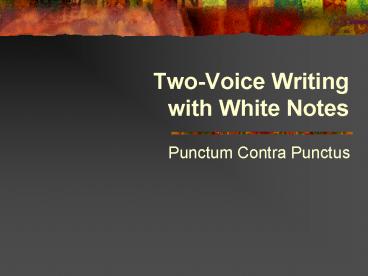TwoVoice Writing with White Notes PowerPoint PPT Presentation
1 / 12
Title: TwoVoice Writing with White Notes
1
Two-Voice Writing with White Notes
- Punctum Contra Punctus
2
Counterpoint
- The ear tends to switch back and forth between
lines because it is hard to follow two or more
parts simultaneously. - Maximize the distinct properties of each voice
because the voices are of equal importance.
3
Basic Principles
- The parts need their own unique pitch range.
- Some voice crossing is allowed but can lead to
confusion of the lines. - The parts must be melodically independent.
- Use a mixture of contrary, similar, and oblique
motion. - Too much similar or oblique motion results in one
voice sounding like the melody and the other
simply an intervalic coupling. - Contrary motion tends to dominate but using
contrary motion exclusively is also bad.
4
Basic Principles
- Vertical simultaneities are mostly consonant.
- The use of dissonance is highly regulated.
- Rhythmic independence is essential.
- Generally, while one voice is moving the other is
sustaining. - The interplay of movement between the lines is
fundamental to preserving the independence of
voices.
5
Harmonic Intervals
- Intervals are always figured from the bottom
voice. - In a 3-part (or more) texture, this means
dissonance is figured from the bottom voice. - The consonant intervals are the Perfect Unison,
Fifth, and Octave, and Major and Minor 3rds and
6ths. - The Major and Minor 10th and Perfect 12th are
permitted, however the lines most commonly stay
within an octave of each other. - Any 2nd, 7th, Perfect 4th, and Augmented or
Diminished interval must be treated according to
the accepted uses of dissonance.
6
Harmonic Intervals
- A Perfect Unison, Octave, or Fifth is used when
both parts start simultaneously. - Consult figure 1-7, page 13 for preferred initial
pitches. - The first note must be at least a semibreve
(whole note) in duration. - Only the Perfect Unison and Octave are used for
interior or final cadences. - Both voices must move stepwise to the final
pitch. - Either a Minor 3rd moves to a Unison, or a Major
6th moves to an octave. - Ficta is used with cadences on D, G, and A to
create a leading tone.
7
Harmonic Intervals
- Perfect consonances within a phrase have specific
voice leading requirements. - Unisons are only used on weak beats, must be
approached and left by contrary or oblique
motion, and their use should be limited. - Octaves are used on weak beats, only very
occasionally on strong beats, must be approached
and left by contrary or oblique motion, and their
use should be limited. - Perfect fifths are approached by contrary or
oblique motion, similar motion is rare and one
voice must be stepwise while one voice leaps, use
on consecutive strong beats is possible if an
imperfect consonance intervenes. - Patterns of successive 6-5s are common.
8
Harmonic Intervals
- Parallel Perfect Intervals are forbidden!
- 3rds, 6ths, and 10ths can be approached and left
freely. - More than 3 consecutive occurrences of the same
imperfect consonance in similar motion severely
weakens the independence of voices.
9
Dissonant White Notes
- Passing Tones and Suspensions are the only types
of dissonance allowed with minims. - Passing tones only occur on weak beats.
- They can be ascending or descending.
- They must pass against at least a semibreve.
- Do not reiterate the note that is against the
passing tone.
10
Dissonant White Notes
- Suspensions occur on strong beats.
- They consist of three parts
- Preparation -- occurs on a weak beat
- Suspension -- occurs on the strong beat
- Resolution -- occurs on the weak beat.
- The Preparation is usually tied to the Suspension
except in the rare case that there is a new
syllable. - The 7-6 and 2-3 are the most common in 2 voices.
- The 4-3 is possible and avoid the use of an A4.
- Avoid the 9-8 because of the resolution to the
8va. - In the 7-6 and 2-3 it is possible to have
non-suspended voice leap to a consonance --
change of part.
11
Cadences/Imitation
- Cadences are always feature a 7-6 suspension
resolving to an octave or a 2-3 suspension
resolving to a unison. - Dont forget the proper ficta when appropriate.
- The Phrygian cadence (F-E D-E) can also be
used on A when B-flat is used (B-flat-A G-A). - Cadences fall on strong beats.
- The final cadence is always a breve in length,
even if it falls on beat 3. - Points of Imitation are the norm for the
beginning of a composition and for the
introduction of new text and thematic material
that appears after an interior cadence.
12
Imitation
- Regarding the opening Point of Imitation in a
two-voice composition - The temporal distance before the imitating voice
enters is an even number of beats -- 2, 4, 6, or
8. - The most common interval of imitation is the 8va,
5th, 4th, and sometimes the unison. - Either voice can begin the composition.
- The second voice begins with strict imitation for
a few measures and then free counterpoint is
used, called fuga -- otherwise it is a canon. - The imitating voice maintains the exact intervals
-- real answer -- the tonal answer is rare. - The subject usually scans in one of the three
hexachords -- C-A (naturale), F-D (molle), and
G-E (durum). - With imitation at the 4th or 5th the naturale is
answered by the durum, the molle is answered by
the natural, and vice versa -- it maintains the
placement of the half-step (Mi-Fa).

